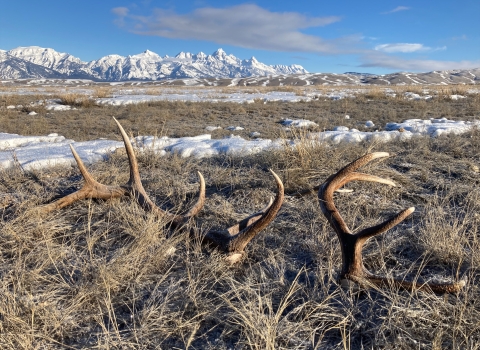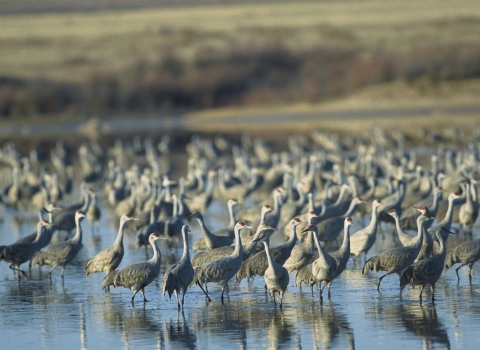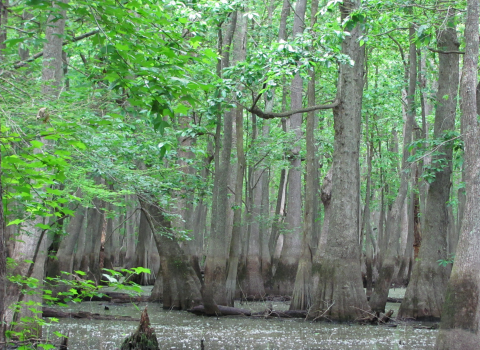Update to original story
Those words echoing again with news of yet two more roadway fatalities. More red wolves taken too soon.
On the heels of the death of red wolf 2216, two more wolves are now victims of roadway deaths this year. Four red wolves no longer part of the pack.
Recently released from an acclimation pen at Alligator River NWR, red wolves 2236, a male from the Wolf Conservation Center in New York, and 2310, a female from the Endangered Wolf Center in Missouri, were killed earlier this week.
Their deaths are reminders of the difficulties the Service and their partners with the Species Survival Plan (SSP) program face in creating a thriving population of red wolves in this stretch of northeastern North Carolina. A population the Service and SSP partners hope to keep from dipping into single digits.
The first vehicle fatality for the year was a male red wolf translocated from St. Vincent NWR to Alligator River NWR, one of two males transferred from the Florida refuge. The other male red wolf remains paired with a resident female … hope for a next generation.
Each death adds to the angst every time more red wolves are released from captivity into the wild. What will their struggles be? Will they survive the challenge of cars on the highways and byways that transect this stretch of wilderness? Issues that a population with such low numbers faces … a population that relies on such releases, at least initially.
Limited signs warning of the presence of red wolves in this area have a purpose … wildlife lives here. They have no experience with roads. But humans do.
With no easy answers for animals naive to roads and fast-moving vehicles, every animal counts. Each and every one, much too important to lose.
June 9, 2021: Roadway collision suspected in red wolf’s death
The recent death of an endangered red wolf in northeastern North Carolina underscores what Joe Madison has learned in years of working with wolves: Mortality stalks them.
Madison, who oversees the program in eastern North Carolina for the U.S. Fish and Wildlife Service (Service) – a region that includes Alligator and Pocosin Lakes National Wildlife Refuges – can cite reasons for the red wolf’s one-step-ahead sprint from extinction.
Human persecution, habitat degradation, and – in the apparent case of the June 3 death of red wolf 2216 – collisions take a toll on Canis rufus.
“Life can be tough for a lot of species, and red wolves are no exception,” said Madison, who manages a program comprising what the Service estimates is currently about 20 wild red wolves. “Human-caused mortalities, such as vehicle strikes, lower the average life span of a wild red wolf from around nine years to less than four.”
The red wolf’s death, say Service officials, highlights the difficulty that accompanies every decision to release more into the wild. Each time that happens, a red wolf faces cars, trucks and people – all potential challenges to its survival. Despite that, a wild population relies on such releases.
The red wolf was one of four adults brought to northeastern North Carolina in late April this year. The quartet’s arrival capped intense, behind-the-scenes work that goes into restoring red wolves to a small slice of their native range. They had to be the right age, with sufficient genetic diversity to birth healthy pups. The newcomers also had to be relatively unaccustomed to human contact.
Two came from a red wolf-captive breeding center in Missouri, a third from a facility in New York, and the fourth – 2216 – from Wolf Haven International in Washington. Two males, two females: Biologists paired them, then put each couple in temporary enclosures at Pocosin Lakes and Alligator River NWRs where the Service hoped to get them acclimated to their new surroundings.
(In a related move, the Service brought four red wolf pups born at the Akron Zoo to Pocosin Lakes. They placed the pups, whose eyes hadn’t yet opened, within the den of a wild female to be raised. This tactic has proven extremely successful and has served as a model for wolf programs elsewhere in the United States. They appear to be doing well.)
Biologists also outfitted each animal with a bright-orange GPS collar. They would be essential in tracking the red wolves after their release. The devices augment extensive monitoring from the ground, which continues on a day-to-day basis.
Several weeks later, one collar triggered an email: a red wolf in “mortality mode.” That’s how biologists found red wolf 2216, dead on the edge of one of the rural roads running through that neck of the woods. She appeared to have been struck and killed; necropsy results are pending. The red wolf, 4 years old, was the second roadway death this year.
Service figures show that vehicle strikes are the second leading cause of red wolf deaths; only gunshots claim more lives. Red wolves released from captivity have no prior experience with roads, and may be attracted to roadkill – and, in the process, become victims themselves.
A limited number of signs alert motorists that they may encounter red wolves as they drive through the area, Madison noted. The Service also is looking into the possibility of using electric messaging boards to alert drivers when they enter red wolf territory.
“But you cannot teach red wolves about vehicles,” he said.
News of 2216’s death hit hard at Wolf Haven International, where the red wolf was raised to adulthood.
“We are deeply saddened by the news (of the red wolf’s death) but we are grateful that she at least got to experience a couple of months of freedom and autonomy,” said Wendy Spencer, the nonprofit’s director of operations. “And we are so grateful to the dedicated field team from (Fish and Wildlife Service) who did their best to keep her safe.
“We understand that any time captive red wolves are released that there are risks, it is the reality of recovery and a very sad unintended consequence in order to ensure that red wolves persist in the wild.”
The death of 2216 is a footnote in the Service’s growing volume of information detailing the lives of the red wolves that roam the refuges. While some red wolves have died, others are doing what nature – and biologists – intended. They are living wild.
Other wildlife organizations share the Service’s hopes for the red wolf and hail the move as a positive step in keeping viable one of the nation’s iconic species – the red wolf, padding along forest floors, slipping into wooded shadows.
Another cause for optimism: The Association of Zoos and Aquariums, a nonprofit dedicated to wildlife education and preservation, has a species survival plan tailored for red wolves. They are doing well in captivity. Some will be released into the wild.
Still, this latest death is another reminder of the wolf’s uncertain future, as well as the Service’s role in tipping the odds in its favor. Biologists have their fingers crossed.
For now, three more adult red wolves are on the landscape at the two refuges in northeastern North Carolina. Until earlier this year, they had spent their lives in captivity. Now they are free to roam, to usher in another generation of red wolves.
Biologists, meantime, hope motorists follow speed limits, and be aware of wildlife near the roadways. Those signs are in place for a purpose. They’re reminders that imperiled creatures may be nearby.





